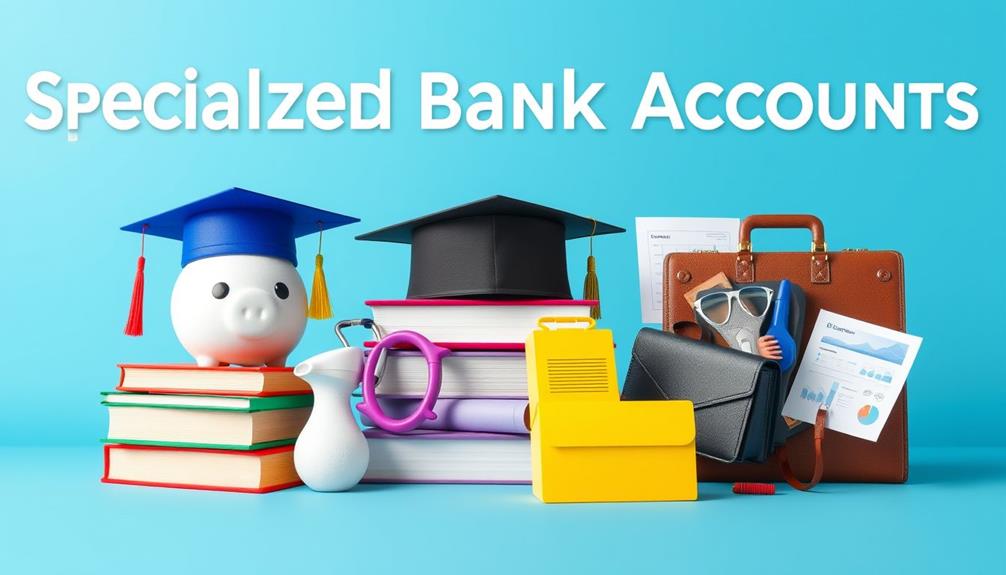Choosing the right bank account type is essential for managing your finances effectively. Checking accounts are perfect for daily spending, while savings accounts help you build an emergency fund and earn interest. If you want higher returns with more liquidity, consider money market accounts. For long-term savings, certificates of deposit (CDs) offer better rates but require you to lock in your funds. Specialized accounts for students or seniors can also cater to specific needs. Understanding these options can greatly enhance your financial strategy, and exploring further will reveal even more insights on making the best choice.
Key Takeaways
- Different bank account types, like checking, savings, and CDs, cater to various financial needs and goals.
- Checking accounts offer easy access for daily transactions, while savings accounts earn interest for future savings.
- Money Market Accounts provide higher interest rates with some transaction flexibility, ideal for larger balances.
- Certificates of Deposit (CDs) lock funds for a term but yield higher interest rates compared to traditional savings accounts.
- Specialized accounts, such as student or senior accounts, address specific demographics and financial situations effectively.
Overview of Bank Account Types

Choosing the right bank account type can greatly impact your financial management. You have several options, each designed to meet different needs.
Checking accounts are perfect for everyday transactions, allowing easy access to funds through debit card purchases and check writing. They usually come with lower fees compared to other accounts, making them a popular choice for daily use. Additionally, diversifying your savings strategy can enhance financial security, similar to how one might consider the benefits of converting 401k to Gold IRA for retirement planning.
If you're looking to save, consider a savings account. These accounts earn interest on your deposits but limit the number of monthly withdrawals.
For a blend of both, money market accounts (MMAs) offer higher interest rates than traditional savings accounts while still allowing some transactions each month.
Certificates of Deposit (CDs) can be an excellent option for long-term savings. They feature fixed interest rates for specific terms and generally provide higher annual percentage yields (APY) than standard savings accounts. However, keep in mind that penalties apply for early withdrawals.
Lastly, various specialized accounts, like student or senior accounts, are tailored to meet specific preferences and financial needs.
Always review minimum balance requirements and interest rates before deciding on the best account for your situation.
Checking Accounts Explained

Checking accounts are often essential for managing your daily finances. They're designed for everyday spending, giving you easy access to funds for debit card purchases, bill payments, and cash withdrawals. Many checking accounts offer convenient features like online banking and mobile deposits, making frequent transactions a breeze.
Just as diversifying your retirement portfolio can enhance financial stability, selecting the right checking account can also provide security and ease in managing funds for immediate needs a hedge against inflation.
When you open a checking account, you'll typically need an initial deposit ranging from $25 to $100, depending on the financial institution. Some accounts, like high-yield checking accounts, provide higher interest earnings than standard options, which can be a nice perk.
However, be mindful of potential fees. Monthly maintenance fees, overdraft fees, and ATM fees can add up, but many banks, particularly online banks and credit unions, offer accounts with low or no fees.
With the right checking account, you can effectively manage your everyday spending while enjoying the benefits of ATM access and other convenient features.
Understanding Savings Accounts

Understanding Savings Accounts
Designed to help you save for the future, savings accounts are an important tool for putting aside funds that aren't needed for immediate expenses. These accounts typically earn interest on your deposits, which can help grow your savings over time. The annual percentage yield (APY) on savings accounts can vary considerably, with online banks often providing higher rates compared to traditional banks. As of July 2023, the average APY was 0.42%.
For those seeking to manage their finances effectively, it's vital to evaluate options like a Gold IRA for long-term savings growth. Most savings accounts have lower minimum balance requirements, making them more accessible if you're looking to build an emergency fund or save for specific goals. However, keep in mind that federal Regulation D limits withdrawals or transfers to six per month. Exceeding this limit can result in fees, so it's wise to plan your withdrawals carefully.
Many savings accounts offer convenient features, such as ATM access for easy withdrawals, but they usually don't allow check writing. This distinction makes savings accounts a practical choice for those who want to save while still having some access to their funds when necessary.
Money Market Accounts Overview

Money Market Accounts (MMAs) can be an attractive option if you're looking to earn more interest on your savings while retaining easy access to your funds. Typically, MMAs offer higher interest rates compared to traditional savings accounts, allowing you to earn more on deposits.
Additionally, adopting a holistic lifestyle approach can enhance your financial well-being by encouraging mindful spending and saving habits. They also provide the flexibility of limited check-writing privileges and debit card access, combining features of both checking and savings accounts for flexible use of funds.
However, keep in mind that Federal Regulation D limits certain types of withdrawals and transfers to six per month, and you may incur fees if you exceed this limit.
Opening an MMA usually requires a higher initial deposit and a minimum balance, which can vary from bank to bank. Some institutions offer tiered interest rates, meaning that maintaining a larger balance may help you earn even higher rates.
Certificate of Deposit Features

If you're considering options for growing your savings, Certificates of Deposit (CDs) stand out as a solid choice. These fixed-term deposits typically offer higher interest rates compared to traditional savings accounts, with average one-year CD rates around 1.72% as of July 2023.
Additionally, just like diversifying your retirement portfolio with gold IRAs, investing in CDs can provide a secure way to earn interest while protecting against inflation. You'll find various term lengths, ranging from 28 days to over 10 years, and generally, longer terms yield higher annual percentage yields (APYs).
While CDs are a great way to earn more on your savings, keep in mind that accessing your funds early can incur an early withdrawal penalty. If you want some flexibility, look for no-penalty CDs, which allow for penalty-free withdrawals under certain conditions.
Minimum deposit requirements can vary by institution, so it's wise to shop around. Additionally, many banks offer promotional offers that provide competitive rates for new accounts, giving you even more incentive to invest in a CD.
Specialized Bank Accounts

When it comes to managing your finances, specialized bank accounts can really make a difference. From student accounts that cut costs to rewards checking accounts that offer cash back, there's likely an option that fits your needs.
These accounts are designed with specific benefits that cater to different stages of life or financial habits, ensuring you get the most out of your banking experience.
For example, just like choosing the right unique dog names for your furry friend can enhance their personality, selecting the right bank account can enhance your financial management.
Types of Specialized Accounts
Specialized bank accounts cater to specific needs and demographics, making it easier for individuals to manage their finances effectively.
For students, student accounts are designed with lower fees and no minimum balance requirements, allowing you to budget your limited funds while in school. If you're over 55, senior accounts may be the right fit, offering benefits like higher interest rates and lower fees tailored for retirees.
Additionally, just as individuals are increasingly drawn to IRA rollovers to gold for stability, specialized accounts can help secure your financial future by providing targeted benefits and features.
Rewards checking accounts can be ideal if you want to earn cashback or points on your everyday purchases, combining incentives with competitive interest rates.
If you're focused on healthcare expenses, health savings accounts (HSAs) provide tax-advantaged savings specifically for medical costs, allowing funds to roll over year after year.
For younger savers, youth savings accounts introduce kids and teens to financial literacy, often including lower fees and parental oversight.
Choosing the right specialized account can help you save more effectively and meet your financial goals. Each type of specialized account offers unique features, so consider your specific needs and choose an account that aligns with your lifestyle.
Benefits and Features
In today's banking landscape, specialized accounts offer tailored benefits that cater to your unique financial needs. Whether you're a student, a senior, or teaching your child about money management, these accounts come with features designed for accessibility and affordability.
For example, youth savings accounts often have no minimum balance requirements and low fees, making them perfect for encouraging early savings habits. Additionally, some banks may offer top-rated payment solutions for education sector that integrate seamlessly with educational programs, further enhancing financial education.
Rewards checking accounts allow you to earn cashback or interest on your purchases, incentivizing you to engage more with your finances. If you're looking to maximize your earnings, high-yield checking accounts can offer interest rates above the national average while still providing easy access for daily transactions.
Many financial institutions also promote specialized accounts with limited-time offers, presenting opportunities for higher interest rates or bonuses when you sign up.
Selecting the Right Checking Account

Choosing the right checking account can greatly impact your financial health, especially with options ranging from fee-free accounts to those with monthly maintenance fees. Start by evaluating these fees, which can range from $0 to over $15. Many online banks and credit unions offer fee-free options, making them worth considering.
Additionally, just like with investments in precious metals, understanding the fee structures associated with your account can enhance your financial decision-making, leading to better long-term growth potential in your savings. Consider exploring educational resources to empower your financial choices.
Next, check the minimum deposit requirements to open an account, typically between $25 and $100. Some banks may waive these fees with direct deposits, offering you more flexibility.
Look into the bank's ATM network size; access to thousands of ATMs can help you avoid withdrawal fees that often average around $3 per transaction at non-network ATMs.
Consider additional features such as overdraft protection, which can save you from costly fees that can exceed $30 each time. Also, explore any budgeting tools the bank may offer to enhance your financial management.
Choosing a Savings Account

Evaluating your options for a savings account can lead to better financial growth and security. When choosing a savings account, keep these key factors in mind to guarantee you make the best decision for your needs:
It's important to understand how different account types can impact your overall financial strategy, especially given the rising credit card debt in the U.S. credit card trends may affect your savings goals.
- Annual Percentage Yield (APY): Online banks typically offer rates exceeding 5%, much higher than the national average of 0.42% as of July 2023.
- Initial Deposit: Be aware that many accounts require an initial deposit, which can range from $25 to $100.
- Monthly Withdrawals: Federal Regulation D limits monthly withdrawals to six, so consider how often you'll need access to your funds.
- Fees: Compare the fees charged by traditional banks versus online banks. Online banks often have lower or no monthly maintenance fees.
- ATM Access: Some savings accounts offer ATM access for convenient withdrawals, while others may restrict access to encourage saving.
Aligning Accounts With Financial Goals

When you're aligning your bank accounts with your financial goals, think about where to keep your emergency fund and how to plan for long-term investments.
A high-yield savings account or a money market account can be great for your emergency savings, while certificates of deposit (CDs) might be better suited for your long-term strategies.
Regularly reviewing these choices will help guarantee they continue to meet your evolving needs.
Emergency Fund Allocation
For effective emergency fund allocation, it's crucial to align your accounts with your financial goals. You want to ascertain that your emergency fund is both accessible and productive.
Opt for a high-yield savings account or a money market account, as these options typically offer competitive interest rates and maintain liquidity for swift withdrawals during emergencies.
Here are some key points to evaluate for your emergency fund:
- Save at least three to six months' worth of living expenses.
- Choose high-yield savings accounts with an annual percentage yield (APY) exceeding 5% for better growth.
- Be aware of Federal Regulation D, which limits withdrawals to six per month, preventing impulse spending.
- Regularly review your accounts to find better interest rates or lower fees.
- Keep your emergency fund separate from your regular savings to avoid mixing funds.
Long-Term Investment Strategies
Aligning your bank accounts with your long-term investment goals is essential for building wealth and achieving financial security. High-yield savings accounts and money market accounts are excellent options for your long-term savings goals, often offering interest rates notably above the national average, sometimes exceeding 5% APY. These accounts can help grow your funds over time, while also maintaining liquidity.
Certificates of deposit (CDs) are another solid choice, providing fixed interest rates for specific terms. They're perfect for planning long-term investments with guaranteed returns, typically yielding higher rates than standard savings accounts.
If you opt for money market accounts, consider those with tiered interest rates to maximize earnings based on your balance levels, encouraging a disciplined approach to saving.
Remember to establish an emergency fund in a dedicated savings account. This guarantees financial security, allowing you to pursue strategic long-term investments without the risk of needing to liquidate them prematurely.
Regularly reviewing and adjusting your banking strategies can help align your accounts more closely with your evolving long-term investment goals, ultimately supporting your journey toward financial stability and growth.
Requirements for Opening Accounts

Before you head to the bank, it's essential to know the requirements for opening an account. These can vary widely depending on the bank or credit union and the specific account types you're interested in.
Here's a quick checklist of what you'll typically need:
- Valid identification (like a driver's license or passport)
- Personal information, including your name and address
- Social Security number
- Initial deposit (usually between $25 to $100 or more)
- Proof of income or residency (such as pay stubs or utility bills)
If you're considering a credit union, don't forget to check their membership requirements, which may involve specific eligibility criteria.
Once you have all the necessary documents and information, the account opening process becomes much smoother.
Remember, each bank can have its unique requirements, so it's a good idea to review them beforehand to avoid surprises.
Frequently Asked Questions
What Is the Difference Between Bank Account Types?
Different bank account types serve unique purposes. Checking accounts focus on daily transactions, while savings accounts help you save money. Money market accounts offer higher interest, and CDs lock funds for better rates over time.
What Are the Different Types of Bank Accounts and Why Would You Use Them?
You've got several bank account options: checking for daily needs, savings for emergencies, money market for better interest, CDs for fixed-term savings, and specialized accounts for tailored benefits. Each serves specific financial purposes effectively.
What Is Important When Choosing a Bank Account?
When you're about to choose a bank account, consider the fees, interest rates, accessibility, and features. You wouldn't want hidden costs or limited access to your money, right? Make sure it fits your needs.
What Are the Main Difference Between Different Types of Banking?
Different types of banking serve unique purposes. Checking accounts facilitate everyday transactions, savings accounts grow your funds, money market accounts blend features, CDs offer fixed terms for higher interest, and specialty accounts cater to specific needs.
Conclusion
Now that you've explored the different bank account types, the choice is yours. Will you opt for the flexibility of a checking account, the growth potential of a savings account, or the stability of a CD? Each decision shapes your financial future in ways you might not expect. As you weigh your options, remember: the right account can open new opportunities. What will you choose, and how will it change the way you manage your money?










